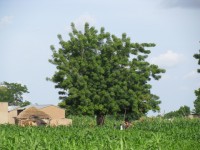February
Routine work: Sodding should now proceed rapidly.
Bush-beans may be planted February 14. On alluvial land it is best to plant them on slight rises as a protection against the rains which sometimes occur toward the end of the month. If frost should threaten just as the beans begin to peep out, cover them an inch deep with the plow or hand cultivator. Sow Early Mohawk first, and at the end of the month sow Early Valentine; a week later sow the wax varieties.
Cabbage: Sow early varieties, such as Early Summer, Early Drumhead, and Early Flat Dutch. Etampes, Extra Early Express, and Winnigstadt sown for small heads in the order named have done very well in southern Louisiana. The earlier sown plants should be transplanted as often as convenient. Should worms cause trouble, dust the plants with a mixture of one part of pyrethrum powder to six of fine dust.
Carrots, celery, beets, endive, kohlrabi, onion sets, parsley, parsnips, radishes and purple-top turnips must now be sown.
Corn: Plant Extra Early Adams, Yellow Canada, Stowell Evergreen, and White Flint toward the middle of the month. Sow again a week later, and again after another week. If the first two sowings fail, the last one will give the early crop.
Cucumbers: Sow and protect with small boxes during cold days and nights, or sow in pots or on sods. Protect the seedlings with sashes or canvas, and plant them out late.
Lettuce: Sow seeds and transplant the plants on hand. This crop requires a soil well supplied with plant-food.
Melons: Plant seeds in the same manner as advised for cucumbers.
Okra: Sow seeds on sods and set out the plants next month.
Peas: Sow seeds of a number of varieties.
Peppers and egg-plants, if not sown last month, should be sown now. Sow them under glazed sashes and keep close. When the plants appear, give some air, and increase it according to the weather. If a large number of plants is required, the sowing may be delayed until next month. Should flea-beetles trouble you, use plenty of bordeaux on egg-plants.
Potatoes, Irish: The main crop should be planted as early as possible. Standard varieties are Early Rose, Peerless, and Burbank.
Strawberries: Run the cultivator through them at least once every three weeks; if they are to be mulched, collect the necessary material. Strawberries planted in February seldom yield much of a crop.
Sweet-potatoes can now be bedded and protected with canvas, or a row or two of whole tubers may be planted for “draws” and vines.
Tomatoes in frames should be given all the air and light possible and plenty of room if protected with canvas, do not allow the plants to crowd.
To request permission to use any material from this site submit your request via e-mail to the Copyright Clearance Center Inc. at www.copyright.com cc neem@neemtree.org. Intellectual property of the corporation, it’s marks, licenses and documents is fully protected by copyright and trademark law, licensed and fully enforced by our intellectual property law firm.™
